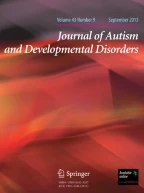Abstract
Potential individual variations in the effectiveness of a shared communication method, facilitated communication (FC), were examined among 20 students with autism and related disorders. To minimize the limits or disadvantages of a single method, we used multiple methods, including auditory or visual input, and simple pointing responses to pictures or words, as well as typing. Data were collected after 6 weeks of FC, and follow-up data up to 7 months later. Findings differed across methods, but there was little clear support for the validity of FC in enhancing communication over communication that students produced independently. Significant facilitator influence of responses was found, but was far less extensive than in other studies. However, an “abdication” pattern of responding was found for some students, in which high performance observed with independent responding was lessenedon trials when FC was introduced. That is, these students may become more passive communicators when FC is used. The complex detected and undetected influences in the process of communication through facilitation are discussed, as well as risk factors in the use of FC.
Similar content being viewed by others
References
Attwood, A. J. (1993).Movement disorders and autism. Paper presented at the International Conference on Autism, Toronto, ON.
Bebko, J. M., Perry, A., & Bryson, S. (1994).Multiple method validation study of facilitated communication. Poster presented at the Annual Child Psychiatry Day, Hospital for Sick Children, Toronto.
Bryson, S., Bebko, J. M, & Perry, A. (submitted for publication). Multiple method validation study of facilitated communication: III. Results of two naturalistic methods.
Bryson, S., Landry, R., & Smith, I. M. (1994). Brief report: A case study of literacy and socioemotional development in a mute autistic female.Journal of Autism and Developmental Disorders, 24, 225–231.
Biklen, D. (1990). Communication unbound: Autism and praxis.Harvard Educational Review, 60, 291–314.
Biklen, D., & Schubert, A. (1991). New words: The communication of students with autism.Remedial and Special Education, 12, 46–57.
Calculator, S. N., & Singer, K. M. (1992). Preliminary validation of facilitated communication (Letter).Topics in Language Disorders, 13, ix-xvi.
Donnellan, A. M., Sabin, L. A., & Majure, L. A. (1992). Facilitated communication: Beyond the quandary to the questions.Topics in Language Disorders, 12, 69–82.
Dunn, L., & Dunn, L. (1981).Manual for Forms L and M of the Peabody Picture Vocabulary Test-Revised. Circle Pines, MN: American Guidance Service.
Frontline. (1993).Prisoners of silence [Documentary]. USA: Public Broadcasting System.
Green, G. (1994). The quality of the evidence. In Shane, H. (Ed.),Facilitated communication: The clinical and social phenomena. San Diego: Singular.
Perry, A., Bebko, J. M., & Bryson, S. (1993). Empirical approach to facilitated communication [Letter].Journal on Developmental Disabilities, 2(1), 123–124.
Perry, A., Bebko, J. M., & Bryson, S. (1994). Validity of facilitated communication [Letter to the editor].Topics in Language Disorders, 14(4), 79–82.
Perry, A., Bryson, S., & Bebko, J. M. (1993). Multiple method validation study of facilitated communication: Preliminary group results.Journal on Developmental Disabilities, 2(2), 1–19.
Perry, A., Bryson, S., & Bebko, J. (1994, March).Multi-method evaluation of facilitated communication: Results and implications. Paper presented at the Ontario Association on Developmental Disabilities Annual Conference, Kingston, Ontario.
Perry, A., Kerr, J., & Vaughan, J. (1992).Augmentative communication training in a girl with autism. Published proceedings of the Technology to Everyone Conference, Chatham, Ontario, November 1991.
Rimland, B. (1993). Controlled evaluations of facilitated communication.Autism Research Review International, 7(3), 7.
Smith, M. D., & Belcher, R. G. (1993). Brief Report: Facilitated communication with adults with autism.Journal of Autism and Developmental Disorders, 23, 175–183.
Wheeler, D. L., Jacobson, J. W., Paglieri, R. A., & Schwartz, A. A. (1993). An experimental assessment of facilitated communication.Mental Retardation, 31, 49–60.
Woods, T. S. (1987). The technology of instruction. In Cohen, D. J., & Donnellan, A. M. (Eds.),Handbook of autism and pervasive developmental disorders. Silver Spring, MD: V. H. Winston.
Author information
Authors and Affiliations
Additional information
The conceptualization of this study was a collaborative process in which all three authors participated equally. We are grateful to the students and parents for their participation in this study. Also, we owe a special debt of gratitude to the facilitators for the essential, but often difficult contributions they made to this project. The study could not have been completed without the help of Carol Haddad and Nancy Freeman, who assisted in data collection and analyses. We thank Sharp Canada for the donation of equipment. We appreciate the support of Thistletown Regional Centre, and particularly the technical assistance of Don Smith and Ken Copeman of the Centre's Audio-Visual Services. Within the TRE-ADD Program, we want to thank the Management Team, especially Gail Gonda, Deb Oreskovich, and Julie Kerr for their support, encouragement, and flexibility. The views expressed in this manuscript are solely those of the authors, and not necessarily those of York University, Thistletown Regional Centre, or the Ontario Ministry of Community and Social Services.
Rights and permissions
About this article
Cite this article
Bebko, J.M., Perry, A. & Bryson, S. Multiple method validation study of facilitated communication: II. Individual differences and subgroup results. J Autism Dev Disord 26, 19–42 (1996). https://doi.org/10.1007/BF02276233
Issue Date:
DOI: https://doi.org/10.1007/BF02276233
